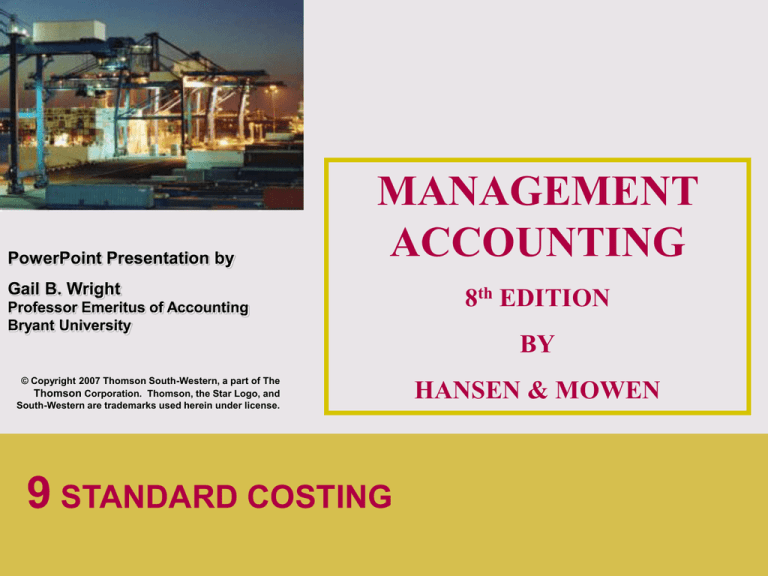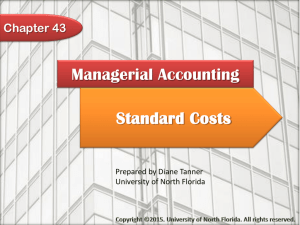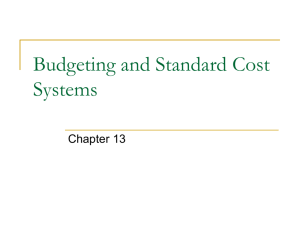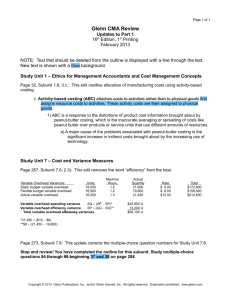variable overhead variance
advertisement

PowerPoint Presentation by MANAGEMENT ACCOUNTING Gail B. Wright Professor Emeritus of Accounting Bryant University 8th EDITION BY © Copyright 2007 Thomson South-Western, a part of The Thomson Corporation. Thomson, the Star Logo, and South-Western are trademarks used herein under license. HANSEN & MOWEN 9 STANDARD COSTING 1 LEARNING OBJECTIVES LEARNING GOALS After studying this chapter, you should be able to: 2 LEARNING OBJECTIVES 1. Tell how unit standards are set; why standard costing systems are adopted. 2. State the purpose of a standard cost sheet. 3. Describe basic concepts underlying variance analysis & explain how they are used for control. Continued 3 LEARNING OBJECTIVES 4. Compute materials & labor variances; explain how they are used for control. 5. Calculate variable & fixed overhead variances & give their definitions. 6. Prepare journal entries for variances (Appendix). Click the button to skip Questions to Think About 4 QUESTIONS TO THINK ABOUT: Blue Corn Foods What motivated Rosita to implement a more formal cost control system? 5 QUESTIONS TO THINK ABOUT: Blue Corn Foods Why does a standard cost system provide more detailed control information? 6 QUESTIONS TO THINK ABOUT: Blue Corn Foods What type of control is being exercised with the use of standards? 7 QUESTIONS TO THINK ABOUT: Blue Corn Foods How can standards be used to control costs? 8 LEARNING OBJECTIVE 1 Tell how unit standards are set; why standard costing systems are adopted. 9 LO 1 QUANTITY STANDARDS: Definition Tell the amount of input that should be used per unit of output. 10 LO 1 PRICE STANDARDS: Definition Tell the amount that should be paid for the quantity of input used. 11 LO 1 Where do quantity & price standards come from? Quantity standards come from experience, studies, & personnel. Price standards come from operations, purchasing, personnel, & accounting. 12 LO 1 What is the difference between ideal and attainable standards? Ideal standards only work under perfect conditions. Attainable standards can be achieved under efficient operating conditions. 13 LO 1 STANDARD COST SYSTEMS Why adopt a standard cost system? For planning & control To improve performance measures To give manager more information by decomposing total variances into price & usage variances For product costing To use unit cost system that is readily available in pricing 14 LO 1 COST ASSIGNMENT Standard costs are readily available for product costing in a standard cost system. EXHIBIT 9-1 15 LEARNING OBJECTIVE 2 State the purpose of a standard cost sheet. 16 LO 2 STANDARD COST PER UNIT: Definition Is the sum of standards costs for direct materials (DM), direct labor (DL), & overhead. 17 LO 2 BLUECHITO COST SHEET Standard cost sheet provides details for standard cost measures. EXHIBIT 9-2 18 LEARNING OBJECTIVE 3 Describe basic concepts underlying variance analysis & explain how they are used for control. 19 LO 3 TOTAL BUDGET VARIANCE: Definition Is the difference between actual cost & planned cost of production. 20 LO 3 FAVORABLE & UNFAVORABLE The difference between actual & planned can be favorable (actual price or usage < standard) or unfavorable (actual price or usage > standard). Does not mean good or bad! 21 LO 3 What should we do when we find variances? If variances are significant, that is if they are beyond our control limits, they should be investigated if it is cost beneficial to do so. 22 LO 3 FORMULA: Total Variance Total variance is Actual cost – Applied cost or Total cost – Standard cost. Total Variance = (AP X AQ) – (SP X SQ) = Actual price x Actual quantity – Standard Price x Standard Quantity 23 LO 3 How can we make total variances more useful? Total variances provide more information if they are divided into Price variances & Efficiency variances. 24 LEARNING OBJECTIVE 4 Compute materials & labor variances; explain how they are used for control. 25 LO 4 FAVORABLE & UNFAVORABLE Repeat: The difference between actual & planned can be favorable (actual price or usage < standard) or unfavorable (actual price or usage > standard). Does not mean good or bad! 26 LO 4 BLUE-CORN FOODS, INC.: Background Information for actual production, cost of corn, & inspectors. Actual production 48,500 bags corn chips Actual cost of corn 780,000 ounces @ $0.0069 Actual cost of inspectors 360 hours @ $7.35 = $2,646 27 LO 4 TOTAL MATERIALS & LABOR VARIANCES Compares actual costs with budgeted costs at level of production. EXHIBIT 9-5 28 LO 4 MATERIALS VARIANCES Decompose total materials variance into price & usage variances. EXHIBIT 9-6 29 LO 4 FORMULA: Materials Price Variance (MPV) Materials price variance tells whether a company paid more than expected for raw materials. MPV = (AQ X AP) – (AQ X SP) = (AP – SP)AQ = ($0.0069 - $0.0060) 780,000 = $ 702 U 30 LO 4 Who is responsible for a materials price variance? The Purchasing Agent. 31 LO 4 MPV AS PERFORMANCE EVALUATION Limitations on using price variance in performance evaluation: buying lower quality or too much inventory. Results of investigation show shortage of usual grade of corn; purchasing agent has no control over supply. 32 LO 4 FORMULA: Materials Usage Variance (MUV) Materials usage variance tells whether a company used more raw materials than expected. MUV = (AQ X SP) – (SQ X SP) = (AQ – SQ)SP = (780,000 – 873,000) $0.006 = $ 558 F 33 LO 4 What is the percentage & source of the favorable MUV? The 10.7% favorable MUV results from higher quality corn. 34 LO 4 Who is responsible for a materials usage variance? The Production Manager. 35 LO 4 LABOR VARIANCES Decompose total labor variance into rate & efficiency variances. EXHIBIT 9-7 36 LO 4 FORMULA: Labor Rate Variance (LRV) Labor rate variance tells whether a company paid more than expected for labor. LRV = (AH X AR) – (AH X SR) = (AR – SR)AH = ($7.35 - $7.00) 360 = $ 126 U 37 LO 4 What is the percentage & source of the unfavorable LRV? The 5% favorable MUV results from market forces & unexpected overtime. 38 LO 4 FORMULA: Labor Efficiency Variance (LEV) Labor efficiency variance tells whether a company used more labor than expected. LEV = (AH X SR) – (SH X SR) = (AH – SH)SR = (360 – 339.5) $7 = $ 143.50 U 39 LO 4 What is the percentage & source of the unfavorable LEV? The 6% favorable LEV resulted from machinery breakdown. 40 LO 4 Who is responsible for a labor efficiency variance? The Production & Maintenance Managers. 41 LEARNING OBJECTIVE 5 Calculate variable & fixed overhead variances & give their definitions. 42 LO 5 VARIABLE OVERHEAD: Background Variable overhead rate (standard) Actual variable overhead costs Actual hours worked (machining & inspection) Bags of chips produced Hours allowed for production Applied variable overhead $3.85 per DLH $1,600 400 48,500 378.3 $1,456 43 LO 5 FORMULA: Total Variable Overhead Variance Total overhead variance is the difference between actual and applied variable overhead. Total Variable Overhead = Actual – Applied Overhead = $1,600 - $1,456 = $ 144 U 44 LO 5 VARIABLE OVERHEAD VARIANCE Decomposes total variable overhead variance into spending & efficiency variances. EXHIBIT 9-8 45 LO 5 FORMULA: Variable Overhead Spending Variance Variable overhead spending variance measures aggregate effect of actual variable overhead rate with standard rate. Spending Variance = (AVOR X AH) – (SVOR X AH) = (AVOR – SVOR)AH = ($4.00 - $3.85) 400 = $ 60 U 46 LO 5 VARIABLE OVERHEAD SPENDING VARIANCE Variable overhead spending variance arises because prices change. It includes things such as indirect materials, indirect labor, electricity maintenance, etc. Increase or decrease in these items is beyond control of managers. 47 LO 5 FORMULA: Variable Overhead Efficiency Variance Variable overhead efficiency variance measures change in variable overhead consumption because relies on direct labor. Efficiency Variance = (AH – SH)SVOR = (400 – 378.3) $3.85 = $ 84 U 48 LO 5 FIXED OVERHEAD: Background Budgeted or Planned Items Budgeted fixed overhead $749,970 Practical activity 23,400 DLH Standard fixed overhead rate $32.05 Actual Results Actual production Actual fixed overhead cost Standard hours allowed for actual production 2,750,000 bags of chips $749,000 21,450 49 LO 5 FORMULA: Applied Fixed Overhead Applied Fixed Overhead = SFOR x Standard hours = $32.05 x 21,450 = $ 687,473 50 LO 5 FORMULA: Total Fixed Overhead Variance Total fixed overhead variance is the difference between actual and applied fixed overhead. Total Fixed Overhead Variance = Actual – Applied Overhead = $749,000 - $687,473 = $ 61,527 Underapplied 51 LO 5 FIXED OVERHEAD VARIANCES Decompose total fixed overhead variance into spending & volume variances. EXHIBIT 9-11 52 LO 5 FIXED OVERHEAD SPENDING VARIANCE Fixed overhead spending variance is the difference between actual and budgeted fixed overhead. It includes things such as salaries, depreciation, taxes, and insurance. Increase or decrease in these items is beyond control of managers. 53 LO 5 FORMULA: Fixed Overhead Volume Variance Fixed overhead volume variance measures the effect of actual output differing from output used to compute predetermined standard fixed overhead rate. Volume Variance = Budgeted – Applied fixed overhead = $479,970 - $687,473 = $62,497 U 54 LEARNING OBJECTIVE 6 Prepare journal entries for variances (Appendix). 55 LO 6 JOURNAL ENTRIES Blue Corn must write journal entries to enter information for variances into accounting records. Variances are closed into Cost of Goods Sold. 56 CHAPTER 9 THE END 57






